Table of Contents[Hide][Show]
A nourishing homemade baby formula using safe, whole ingredients. This recipe was developed and tested by Dr. Mary Enig, a PhD Nutritionist and originally published in Nourishing Traditions cookbook in 1996. It was formulated to match breastmilk as closely as possible and is also suitable for infants. Source: Weston A. Price Foundation
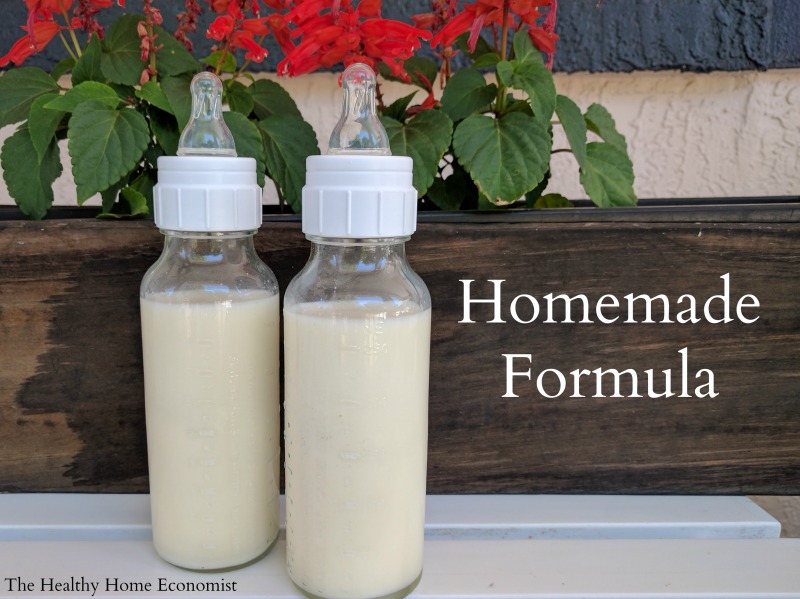
There is no doubt that breastfeeding your baby is the best option for the child’s long-term health and development. Human breastmilk from a well-nourished mother is the perfect food for baby. However, in circumstances where the child is adopted or the Mother finds herself unable to breastfeed, formula feeding becomes necessary. In those cases, homemade baby formula is best.
Using a baby formula recipe that closely matches the nutritional profile of breastmilk is a far better choice than even organic baby formula from the health food store. More on this below.
Note: Donor programs are widely available for human breastmilk. But, the diets of the donor mothers are unknown and most likely nutritionally insufficient. In addition, breastmilk banks pasteurize the donated breastmilk which destroys much of the nutritional benefit. Unless you are fortunate to have a trusted and direct donor milk source in your community, avoid this option!
Dangers of Commercial Formula
Commercial formulas are always a poor choice for a number of reasons. First of all, formula manufacturers line the cans with the chemical BPA. This substance disrupts hormone development and is a probable contributor to early puberty in girls, and ADHD, urogenital abnormalities, and other ills in boys.
The European Food Safety Authority found that canned commercial formula is a significant source of BPA for infants, exposing the child to 13mcg of BPA per kg of body weight per day! BPA-free formula cans are no better. The chemical BPS is typically used instead which is just as dangerous.
Beware that manufacturers pack even organic commercial formula like Earth’s Best in BPA cans. Worse, they use organic brown rice syrup as the primary sweetener which is known to be frequently contaminated with arsenic.
In addition, all commercial milk formulas are processed at extremely high temperatures which violently denature the fragile milk proteins, render them allergenic, and add carcinogens to the final product. Soy infant formula is the worst. Obscenely high processing temperatures not only denature the proteins but large levels of phytic acid in soy block mineral absorption by the infant. Moreover, soy-based plant estrogens disrupt the hormonal development of the baby!
It seems that for the concerned Mother who is unable to breastfeed, learning how to make baby formula at home with safe, pure ingredients is the most prudent way to go!
Why Make Homemade Formula Even if You Are Breastfeeding
In the video below, I show you how to make your own safe, healthy raw milk homemade formula for your baby.
The recipe I follow was originally published in the cookbook Nourishing Traditions in 1996 and developed by Dr. Mary Enig.
Even though I breastfed each of my children for at least 2 years, I made this exact formula for my own children when I was away for the day or the evening as pumping was not an option that worked well for me.
I even used this homemade formula for an entire day once when I had some dental work done and was advised to pump and discard for 24 hours.
As a result, even successfully breastfeeding Moms can use this wonderful homemade formula as a supplement when necessary to their own nutrient-dense breastmilk!
It is advised that even breastfeeding Mothers have the ingredients for this formula on hand for an emergency. If Mom is sick or otherwise unable to nurse, Dad can step in and make this safe alternative until Mom is back on her feet. It takes a few days to a week to gather all the ingredients together to make this formula, which is why I advise having them on hand at all times.
Homemade Most Nutritious
The image below lists the reasons why it is worth it nutritionally to make formula yourself for your precious baby!
You can order all of the required ingredients for the homemade baby formula in one package from this reputable, vetted source.
Moms who have successfully used this formula feeding your children, please post about your experience in the comments section to encourage those who are considering it and need some Mom to Mom encouragement!
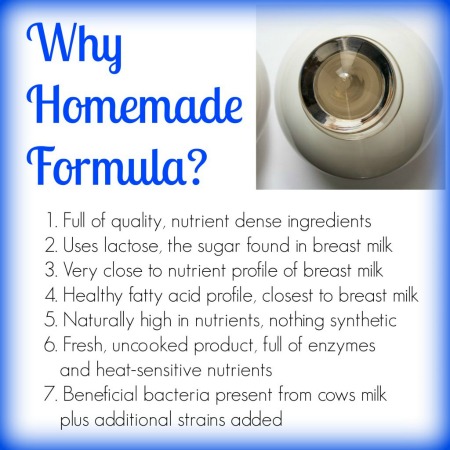
Where to Source Quality Milk
The most widely available grass-fed milk around the world is from cows. This is usually the most budget-friendly and easily sourced milk for this recipe for homemade formula.
If only goat milk is available in your area, this recipe for goat milk baby formula can be used instead. When using milk from ewes, please refer to the linked article for an adjusted recipe; one of the benefits of sheep milk is that it is higher in healthy fats than either goat or cow milk.
Camel milk formula is another option that is a particularly digestible form of dairy and growing in popularity around the world.
Alternatively, you can use low temp (vat) pasteurized, non-homogenized whole milk cultured with a piima or kefir starter. Then substitute the piima milk or kefir for the raw milk portion of the formula recipe. Cold-pressed raw milk also must be cultured before using it as it contains no probiotics.
Do NOT use ultrapasteurized (UHT) milk even if organic as it is too highly processed and extremely allergenic!
It is also best to avoid all types of powdered milk for this recipe. The factory process of making milk powder reduces nutrition considerably and denatures it, which makes it more likely baby will have an allergic reaction.
Dairy Allergy Option
If all types of dairy prove unsuitable for your baby, make this nondairy baby formula recipe instead. It uses a base of homemade bone broth as a substitute for milk. It is important not to utilize a plant-based or otherwise vegan baby formula recipe.
Avoid buying bone broth to make the dairy-free formula. Make it yourself! Manufacturers of commercial bone broth, even if authentic, may water down the end product. This is apparent if it does not gel when chilled in the refrigerator.
Many brands have toxic packaging issues as well. If you must buy it in a pinch, see my shopping guide page for vetted brands that are safe.
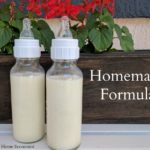
Homemade Baby Formula Recipe (for infants too)
A nourishing baby formula recipe you can make at home with safe, whole ingredients developed and tested by a PhD nutritionist to match breastmilk as closely as possible. Also suitable for infants.
Ingredients
- 2 cups raw cow milk OR organic whole milk yogurt
- 1 7/8 cups filtered water
- 1/4 cup liquid whey
- 4 Tbl lactose
- 1/4 tsp Bifidobacterium infantis powder
- 2-4 Tbl raw or pasteurized cream
- 1/2 tsp cod liver oil unflavored
- 1/4 tsp butter oil unflavored
- 1 tsp sunflower oil preferably organic
- 1 tsp extra virgin olive oil preferably organic
- 2 tsp virgin coconut oil preferably organic
- 2 tsp nutritional yeast
- 2 tsp gelatin
- 1/4 tsp acerola powder
Instructions
-
Fill a 2 cup Pyrex measuring cup with filtered water and remove 2 TBL (this will give you 1 7/8 cup water).
-
Pour about half the water into a pan and turn burner on medium.
-
Add the gelatin and lactose and let dissolve, stirring occasionally.
-
When gelatin and lactose are dissolved, remove pan from heat and add the rest of the water to cool.
-
Stir in the coconut oil and butter oil until melted.
-
Put remaining ingredients in a glass blender.
-
Add the water mixture and blend for about 3 seconds.
-
Place formula in glass baby bottles or a glass jar and refrigerate.
-
Before giving to baby, warm glass bottle in a pan of hot water or a bottle warmer. NEVER microwave baby bottles!
Recipe Video
Recipe Notes
If using raw cow milk from holstein cows, use 4 Tbl of extra cream (otherwise use 2 Tbl extra cream).
If choosing to make this homemade formula with camel milk, be sure to include 4 Tbl extra cream as camel milk is lower in cream than cow milk.
Do not use high oleic sunflower oil. Use only the brand recommended in the ingredients list which is cold pressed, organic, unrefined, and low oleic.
*Do NOT use powdered whey from the store as it is denatured. Avoid whey from making cheese as it will curdle the formula.
*Do not substitute pasteurized or powdered milk as these are heavily processed, denatured and allergenic foods.
*Do NOT use ultrapasteurized (UHT) cream. It is highly allergenic. Raw or pasteurized cream is acceptable.
*Do NOT use fish oil or krill oil instead of high vitamin cod liver oil as they do not contain any Vitamin D and very little to no Vitamin A.
Collagen powder may be substituted for the gelatin in a pinch (more on peptides in baby formula in this article).
If you are wondering where is the iron in homemade baby formula, this article provides an explanation.
If baby experiences constipation using this formula, try adding 1 tsp of molasses to each batch. This should help move things along.
How to Transition to DIY Formula
Once you’ve viewed the video, gathered the ingredients, and made your first batch, how do you feed it to your baby for the first time?
It is important not to switch all at once as this can cause gas, excessive spit-up, or an uncomfortable change in diaper habits such as constipation or overly loose stools.
Start by giving your baby three-quarters of the old formula blended with one-quarter of the homemade. Try this ratio for a day or two and see how your infant responds.
If no digestive upset or major change in diaper habits occurs, increase the amount to a 50-50 blend of old formula to homemade. Observe for another day or two as before.
If no major issues, increase once again to three-quarters homemade formula to one-quarter old formula. If baby does well on this blend for a third time, you are ready to fully transition to the homemade formula.
At any time during the transition, symptoms of intolerance emerge, back up to the previous successful blend ratio and stay there for a day or two before attempting to increase once again.
Homemade Formula FAQ
Weston Price Foundation
Feeding an Adopted Baby
Traveling Tips with Baby Formula Made at Home
Iron in Baby Formula
Collagen Peptides instead of Gelatin for Homemade Formula?


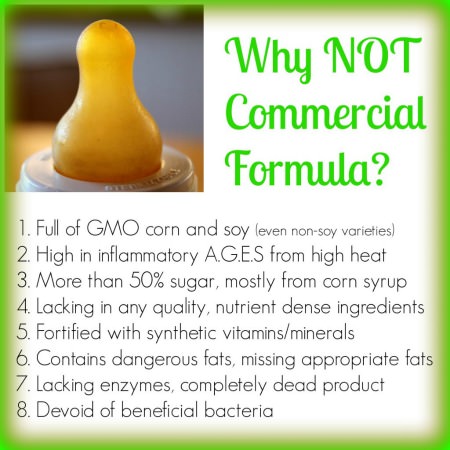
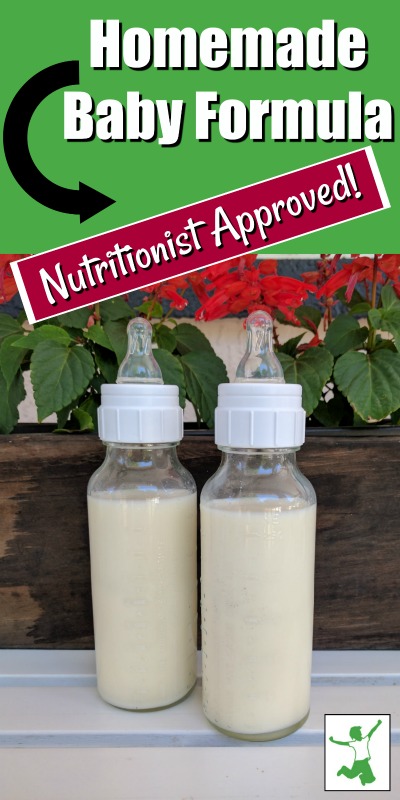






I am about to make my first baby formula, and I wanted to clarify first… do I use 2 cups of the raw milk after it has been separated from the cream, or 2 cups of raw milk with the cream still in it? I see the ingredients say to add additional cream so I wasn’t sure if was in addition to the cream in the milk, or if I was supposed to separate the raw milk first and give her that??? Thank you for the clarification!
Kim
you should use the raw milk with the cream still in it. you need to be using whole milk, and taking the cream out makes it not whole milk anymore. if you need to skim cream to use for the cream in the recipe, you should do that from a different container of milk.
The milk I get is nearly one third cream and has not been sepe rated. I would think most milk has been sepweated bwfore you get it.
What brand of liquid whey do you recommend? The link isn’t working and I don’t want to order the wrong thing:) Thank you!
Hi Sarah,
We have access to raw milk but believe they need to supplement and grain feed during the winter.
Is this acceptable or should I stockpile and freeze the grassfed milk before the first frost?
Thanks for this wonderful alternative! We used Earth’s Best with our first but are happy to find your recipe.
Victoria
If you can easily freeze, that would be great. But supplementing with grain during the winter is acceptable as well.
I have been researching the different ways of eating. I am currently feeding my 8 month old veggies, beans, tofu , fruit etc. I am not a huge milk drinker nor meat eater so I have been looking at different alternatives to getting the same nutrients from other sources. I got thinking of how i’d like to switch the formula my son is on from dairy to soy but then have been reading lots on the estrogen in soy products 😛 Soy I decided to keep him on the similac dairy . Then I came across your blog on homemade formula. I am super nervous to go ahead and do anything like this incase he is not getting what he needs but at the same time trying to get away from all this commercial crap … HELP not sure what to do
She has been solely on this formula for 3 weeks now, at 8 weeks old, and at first there was some obvious discomfort but now she is doing super well on it. I make it every day now and am thrilled that I’ve found the next best thing to breast. I think it takes a few weeks for their newborn digestive tracts to fully get used to it.
We substituted 1/4 dose of a liquid b complex for the yeast. We add 1/2 tsp of good quality grade b maple syrup per 4 oz bottle, a doctor remedy for constipation that works nicely. And sadly we have to use non raw heavy cream, because we can’t find raw. Love that Sprouts carries raw milk! I love this formula. My daughter is thriving on it and it shows. Thanks for your video. I’ve memorized the recipe and enjoy making it each day now. Seriously. It’s kind of fun.
I have been making home made formula for my infant son we recently adopted. We started with the hypoallergenic formula and are now using the milk version. We have a happy healthy baby boy! Our only problem has been that the lactose causes a great deal of gas. We found a great substitute with Coconut Secret crystals. It matches calorie for calorie to the lactose. I just couldn’t give him the cane sugar as a substitute — organic or not. I have tried other brands of coconut crystals, but they seem to have more of the coconut pieces and clog the bottle nipples. I really wish I had known about this formula when we adopted our first child 8 years ago. Although, I did know enough to give her high quality probiotics regularly.
any tricks for the nutritional yeast? I have ground it up finer in my coffee grinder but it still gets stuck in the nipple!
I have had this same problem, but now I’m wondering if it is the Acerola powder! Did you ever find a solution???
I read most all the comments above( i didnt want to duplicate a question). I make theformula exact to the recipe but even right after i make it when i heat it it curdles. my milk is fresh….i heat water and i use glass baby bottles. i heat the water and put the glass bottle in the hot water. a few mins later its curdled milk on top and whey looking liquid below. my baby also has horrible poo now and spits up now and the spit up smells completely rotten and its also curdled. HELP PLEASE!! i’m afraid i’m giving her something bad. 🙁
I am interested in any ones opinion on this issue. I also am having trouble with the milk curdling. I am making the formula and if it is two days old I find that this happens. The milk I use is fresh and not out of date any time soon, yet when it is heated in a low temp. bottle warmer I find if I made it a few days prior, the formula curdles and I have to throw it away. Any idea, from any one, why??? Thanks for your help.
This happens to me too! Did you ever get a response or find a solution??
Hi Sarah! I really enjoy reading your posts and watching your videos. They have been SO helpful!! Thank you for doing this, and for taking the time to answer our questions!! I wanted to know if it is possible to use sheep’s milk to make baby formula. I have read that it is far more nutritious than cow’s milk. What do you think? Thanks again!!!
I’m getting ready to go back to work so I want to start my 5 month old on this homemade formula, I made a fresh batch yesterday and he VOMITED. I have followed the recipe, so I know I am making it right. I’m currently nursing and supplement with Organic Baby’s Only Dairy Formula (which he loves because it taste delicious) so I know he doesn’t have any dairy allergies. What can be going wrong? Please HELP!